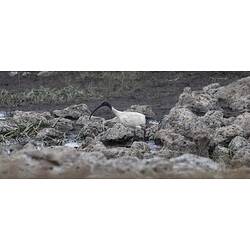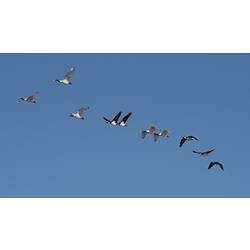General Description
Body completely white. Head and neck black and featherless. Bill long, black and downward curving. Flight feathers have black tips. During the breeding season, the skin patch under the wings turns dark scarlet and the upper tail becomes yellow. Juveniles have a black head and neck feathers. Bill to tail length up to 76 cm. Flocks form distinctive 'V' formations when flying.
Biology
Australian White Ibis form large, often mixed-species colonies and can breed year-round when resources are abundant. Males attract females by establishing a territory on a tree branch, while aggressively driving off other males and performing noisy shows. He will bow from his branch when a female arrives and offer her a twig. A pair-bond is established if the female accepts the twig and they will begin to preen each other. They build a nest at a different location. They mainly feed on aquatic invertebrates, molluscs, crayfish, fish and snakes in their natural habitat, but also scavenge in land-fill sites and human recreation areas. Aquatic food is obtained by probing their long bill into the mud. Molluscs are opened by banging them on a hard surface until they open.
Distribution
Eastern, northern and western mainland Australia and Tasmania.
Habitat
Freshwater wetlands, floodplains, swamps, lagoons, grasslands and some urban areas.
More Information
-
Animal Type
-
Animal SubType
-
Brief Id
A large white bodied bird with black wing tips, a bare black head and a distinctive long curved bill.
-
Colours
Black, White
-
Maximum Size
76 cm
-
Habitats
-
Diet
Omnivore
-
Diet Categories
Insects, Invertebrates
-
Endemicity
-
Commercial
No
-
Conservation Statuses
CITES: Not listed, FFG Threatened List: Not listed, EPBC Act 1999: Not listed, IUCN Red List: Least Concern
-
Taxon Name
-
Common Name
Australian White Ibis
-
Kingdom
-
Phylum
-
Subphylum
-
Class
-
Order
-
Family
-
Genus
-
Species Name
molucca





